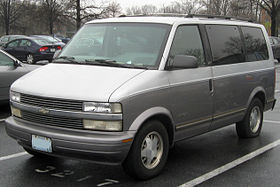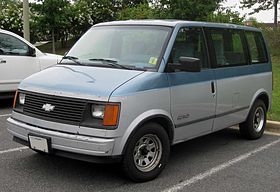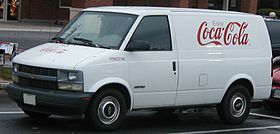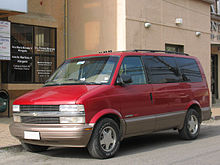Chevrolet Astro
This article needs additional citations for verification. (January 2009) (Learn how and when to remove this template message) |
| Chevrolet Astro/GMC Safari | |
|---|---|
 | |
| Overview | |
| Manufacturer | General Motors |
| Also called | GMC Safari |
| Production | 1985–2005 |
| Assembly | Baltimore Assembly, Baltimore, Maryland |
| Body and chassis | |
| Class | Van |
| Body style |
3-door cargo van 3-door passenger van |
| Layout | Front engine, Rear-wheel drive / All-wheel drive |
| Powertrain | |
| Transmission |
4-speed Automatic 4-speed Manual 5-speed manual |
| Chronology | |
| Successor |
Chevrolet Uplander (Astro, passenger van) Chevrolet Traverse (Astro, passenger van) GMC Acadia (Safari, passenger van) Chevrolet City Express (Astro and Safari, cargo van) Chevrolet Express (Astro and Safari, both cargo and passenger) |
The Chevrolet Astro was a rear-wheel drive van/minivan manufactured and marketed by the American automaker Chevrolet from 1985 to 2005 and over two build generations. Along with its rebadged variant, the GMC Safari, the Astro was marketed in passenger as well as cargo and livery configurations—featuring a V6 engine, unibody construction with a separate front engine/suspension sub-frame, leaf-spring rear suspension, rear bi-parting doors, and a seating capacity of up to eight passengers.
Contents
Background[edit]
Because of their size, and truck-based Car platform, the Astro and Safari not only competed against Dodge Caravan/Plymouth Voyager and the Japanese Toyota Van, but also vehicles such as the Dodge Durango and Honda Pilot. The Astro was marketed as a minivan, though sized between the Chevrolet Venture/Lumina APV unibody minivan and the full-size Chevy Van/Express. Similar to the Ford Aerostar, it had powertrain components in common with GM's other light trucks and up to a 5,500 lb (2,500 kg) towing capacity.
Both Pontiac and GMC have used the Safari nameplate (GMC belonged to the Pontiac/GMC Division, which was later expanded to include Buick); Pontiac used the nameplate on several of its station wagon models from 1955 to 1989. The two Safaris, both Pontiac and GMC, were marketed simultaneously, at times by the same dealerships, from 1985 through 1989. The Pontiac Safari is not a variant of the GMC Safari, and the Chevrolet Astro by extension.
The Astro model name had been used previously for the unrelated Chevrolet Astro 1 Concept car, first shown at the New York Auto Show of 1967.[1][2]
First generation (1985–1994)[edit]
| First generation | |
|---|---|
 | |
| Overview | |
| Production | 1985–1994 |
| Body and chassis | |
| Related |
Chevrolet S-10 GM B platform |
| Powertrain | |
| Engine |
2.5 L Tech IV 98 hp (73 kW) I4 4.3 L 4300 165 hp (123 kW) V6 4.3 L 4300 200 hp (150 kW) V6 |
| Dimensions | |
| Wheelbase | 111.0 in (2,819 mm) |
| Length |
STD: 176.8 in (4,491 mm) EXT: 186.8 in (4,745 mm) 1992–94 Astro Cargo Van STD: 177.9 in (4,519 mm) 1992–94 Astro Cargo Van EXT: 187.9 in (4,773 mm) |
| Width |
77.0 in (1,956 mm) 1992–94 Safari & Astro Cargo Van: 77.5 in (1,968 mm) |
| Height |
1985–89: 73.7 in (1,872 mm) 1985–89 Cargo Van STD: 74.5 in (1,892 mm) 1990–91 STD: 74.9 in (1,902 mm) 1990–91 STD: 74.1 in (1,882 mm) 1992–94 Astro: 76.2 in (1,935 mm) 1992–94 Safari Cargo Van: 76.1 in (1,933 mm) 1992–94 Safari SLX: 76.4 in (1,941 mm) 1992–94 Safari 2WD EXT: 76.6 in (1,946 mm) 1992–94 Safari Cargo Van AWD STD: 75.7 in (1,923 mm) 1992–94 Safari Cargo Van AWD EXT: 76.0 in (1,930 mm) |
Initial advertising boasted that it was a vehicle that will "make you realize that life is too big for a minivan", referring to the Chrysler minivans. The van can have a seating configuration between two and eight passengers.
Engine choices ranged from a 98 hp (73 kW; 99 PS) 2.5 L four-cylinder to a 200 hp (149 kW; 203 PS) 4.3 L V6, depending on options and/or model year.
Much like the second-generation GM F-body 1970-1981 and X-body vehicles, the GM M-van (Astro/Safari) had a bolt-on subframe. For the M-van, the front suspension shares most components with the GM B-body station wagon (Chevrolet Caprice, Oldsmobile Custom Cruiser and larger variants of the Pontiac Safari and Buick Estate Wagon) with a leaf-spring rear suspension. The lower ball joints were larger than their B-body counterparts (similar to 1977-96 Cadillac D platform vehicles, e.g., Fleetwood limousines). These ball joints were later used in the final Chevrolet Caprice 9C1 (police package) cars manufactured in 1995 and 1996. They also shared many mechanical similarities to the GMT 325/330 midsize S/T pickups and utility vehicles.
In 1990 a new all-wheel drive (AWD) system (the first U.S.-built minivan to do so),[3] designed and developed by FF Developments (FFD),[4] was made optional. The AWD models had a lower fuel economy: 17 miles per gallon highway versus 20 to 21 miles per gallon for rear-wheel drive vans. AWD Astros used a Borg Warner 4472 transfer case.
Also in 1990, a new dashboard was introduced along with the availability of an extended body option, sharing its wheelbase with the shorter version. The 1990 model year also introduced the hydroboost braking system, a system using the same accessory belt driven pump to supply the power steering and brakes.
In 1992, a new optional door form was introduced, colloquially known as Dutch doors. This form was two bi-parting doors with a flip-up window above. Previously, Astro and Safari vans were equipped only with bi-parting doors. An optional 4.3 L (RPO L35) engine with central port injection and a balance shaft was phased in.
In 1993, an electronically controlled 4-speed automatic transmission with overdrive became standard as the sole transmission offering. As with many other 1993 model year GM vehicles, Scotchgard fabric protection also became a standard feature on Astro vans equipped with cloth seats. 1994 also saw the addition of three new exterior paint colors. These colors were Indigo Blue Metallic (#39), Light Quasar Blue Metallic (#20), and Medium Quasar Blue Metallic (#80).
For the 1994 model year, GM started manufacturing most of their vehicles, including the Astro and Safari, with CFC-free air-conditioning systems, which used R134a refrigerant instead of R-12 refrigerant.
Second generation (1995-2005)[edit]
| Second generation | |
|---|---|
 | |
| Overview | |
| Production | 1995–2005 |
| Body and chassis | |
| Related |
GMC C/K Chevrolet C/K Chevrolet Express GMC Savana |
| Powertrain | |
| Engine | 4.3 L 190 hp (142 kW) V6 |
| Dimensions | |
| Wheelbase |
1995–96: 111.0 in (2,819 mm) 1997–2005: 111.2 in (2,824 mm) |
| Length | 189.8 in (4,821 mm) |
| Width | 77.5 in (1,968 mm) |
| Height |
1995–96 Astro: 75.9 in (1,928 mm) 1997–98 Astro: 76.0 in (1,930 mm) 1995–96 Safari: 76.2 in (1,935 mm) 1997–98/2002–03 Safari Cargo Van & 1999–2001 Astro Cargo Van 2WD: 75.3 in (1,913 mm) 1997–2005 Safari & 2002–05 Astro: 75.0 in (1,905 mm) 1999–2001 Astro 2WD: 74.9 in (1,902 mm) 1999–2001 Astro Cargo Van AWD: 75.2 in (1,910 mm) 1999–2001 Astro AWD: 74.8 in (1,900 mm) |
In 1995, the model was facelifted with an extended nose that resembled the then-new full-size Express vans; while the original square headlights were retained for use on the cargo vans, the passenger-carrying variants now used horizontally-mounted rectangular headlights that had debuted on the full-size trucks in 1992, and would eventually appear on the smaller trucks in 1998. Also for 1995, the shorter length body was dropped. In 1996, a redesigned dash received a passenger side air-bag. The vans remained mostly unchanged until the end of production in 2005.
In 2003, GM upgraded the chassis of both the Astro and Safari with certain suspension components, larger brakes, and six-lug, 16 inch wheels from the full-size Chevrolet and GMC half-ton pickup trucks.
The last Astro and Safari rolled off the assembly line on May 13, 2005.
Safety and crash testing[edit]
The Insurance Institute for Highway Safety (IIHS), gave the Astro a "Poor" rating in 1996 because of a display of structural failure in the Institute's 40 mph (64 km/h) crash test into a fixed, offset barrier. The underbody of the test van buckled, pitching both front seats forward and shoving the crash dummy into the dashboard and steering wheel, and resulting in a broken left leg, leading the Institute to comment that "[t]he collapse of the occupant compartment left little survival space for the driver."[5]
In testing performed by the National Highway Traffic Safety Administration (NHTSA), however, the Astro and Safari fared better, improving from a single-star rating in 1991 to a three-star (driver) and four-star (passenger) rating by 2000. In side impacts, the Astro and Safari both received the highest, five-star rating in every year that the test was administered.
In 2007, the IIHS reported that the 2001–2004 model year Chevrolet Astro recorded during calendar years 2002–2005 the least number of killed drivers of all passenger vehicles in the United States, as calculated per every million units on the road. Driver's habits and vehicle usage might have influenced this result.[6]
References[edit]
- Jump up ^ "Chevrolet Astro I Concept car". ultimatecarpage.com. Archived from the original on March 3, 2016. Retrieved February 28, 2016.
- Jump up ^ Keefe, Don (December 2005). "1967 Chevy Astro I". Hemmings. Archived from the original on January 5, 2017. Retrieved February 28, 2016.
- Jump up ^ Gunnell, John (1993). Standard Catalog of 4x4's 1945-1993. Krause Publications.
- Jump up ^ "No giant here — FF Developments Ltd. — company profile". Ward's Auto World. December 1999.[dead link]
- Jump up ^ "Vehicle ratings - Chevrolet Astro 1996-2005 models". Insurance Institute for Highway Safety, Highway Loss Data Institute. Archived from the original on June 2, 2006. Retrieved February 28, 2016.
- Jump up ^ "Drivers deaths by make and model: fatality risk in one vehicle versus another" (PDF). Status Report. Insurance Institute for Highway Safety. 42 (4). April 19, 2007. Archived from the original (PDF) on January 17, 2014. Retrieved February 28, 2016.
External links[edit]
- 1985 Chevrolet Astro handbook
- 1986 Chevrolet Astro handbook
- 1987 Chevrolet Astro handbook
- 1988 Chevrolet Astro handbook
- 1989 Chevrolet Astro handbook
- 1990 Chevrolet Astro handbook
- 1991 Chevrolet Astro handbook
- 1992 Chevrolet Astro handbook
- 1993 Chevrolet Astro handbook
- 1994 Chevrolet Astro handbook
- 1995 Chevrolet Astro handbook
- 1996 Chevrolet Astro handbook
- 1997 Chevrolet Astro handbook
- 1998 Chevrolet Astro handbook
- 1999 Chevrolet Astro handbook
- 2000 Chevrolet Astro handbook
- 2001 Chevrolet Astro handbook
- 2002 Chevrolet Astro handbook
- 2003 Chevrolet Astro handbook
- 2004 Chevrolet Astro handbook
- 2005 Chevrolet Astro handbook
![]() Media related to Chevrolet Astro at Wikimedia Commons
Media related to Chevrolet Astro at Wikimedia Commons
| show |
|---|
| show GMC, a marque of General Motors, light truck timeline, international market, 1980s–present
|
|---|





